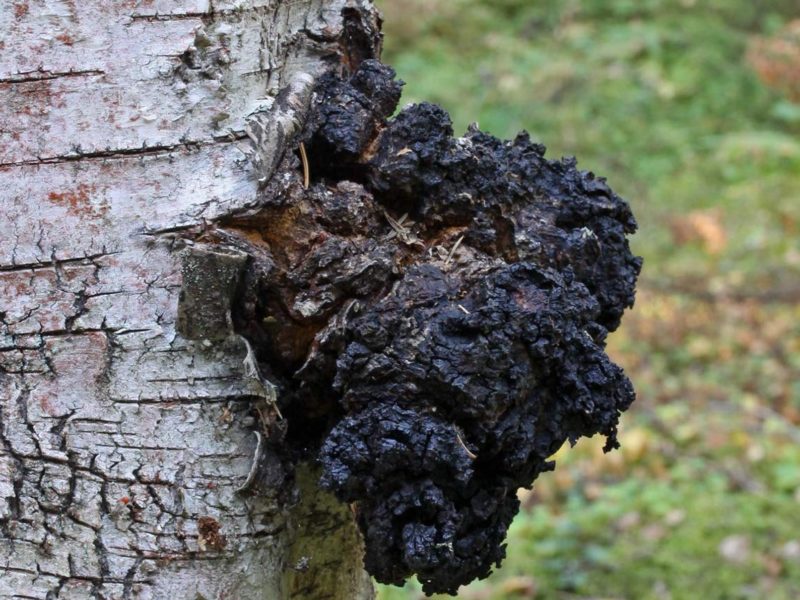Chaga is an aggressive wood-rot fungus that predominately infects birch trees. It has been known to infect other hardwood trees however the biological constituents are not the same as when grown on a birch therefore it is disregarded as being useful.
Many websites and researchers will refer to chaga as a mushroom although botanists are not sure as to whether this is categorically a true mushroom. Chaga is closely related to woody bracket fungi and is classified as a member of the Hymenochaetaceae family. This family includes a number of other dark, woody botanicals that grow on bark and decaying trees such as Willow Bracket (Phellinus igniarius).
On average chaga can grow anywhere up to 30cm (12”) in diametre. It has a very rough, bark-like surface and on the outer surface it is black and gnarly-like. Some chaga can weigh up to 14 kilograms (30 lbs) and each one takes on a unique shape. It’s almost safe to say that no two are alike. The interior of chaga is amber-coloured or yellow to yellow-brown with some bits of white mixed in. It is moderately hard are the inside but the outer surface is harder. Many people think they have discovered chaga when they have come across a burl, a willow bracket, or chaga on another hardwood, but only chaga you want to harvest is the chaga that grows on a birch tree.
Chaga has a symbiotic relationship with the birch tree in which they grow on and it often heals the tree (depending on the extent of the damage). Some researchers have inserted a piece of chaga into a drying tree and have found that in some cases the tree will recover. If a birch is damaged and splintered at the top then chaga will fill in and in time, heal the damaged bark. When wind has caused a tree to lean and rub up against another tree, chaga can heal the lesions in the bark of both trees.
As chaga grows it feeds on the nutrients in the tree. Not only does this ‘fungus’ heal the tree in return but it concentrates the health-nourishing constituents of the birch tree. In essence chaga is a vital chemical factory that provides us with incredible health.
When to Harvest Chaga
Ideally the best time to harvest in the autumn and winter. Wait until there are at least two weeks of straight nights of 5°C (41F) or colder. At this time the birch trees have become dormant for the winter and the chaga is at its peak nutrient values. Harvest throughout the winter until the birch sap starts running. Do not harvest chaga when the sap is running or in the summer months because the chaga will have as much as 80 percent water content diluted many of the nutrients until the next autumn. Birch trees start to stockpile their water and nutrients to survive the coming winter.
Harvest from Living Trees Only
Chaga is technically a parasite so when the tree dies, so does the chaga. Chaga must always be harvested from living birch trees. Some people may not know how to determine a living from a dead birch in the winter months. Living trees produce winter buds so finding living winter buds is evidence that the tree is still alive.
Sustainable Harvesting of Chaga
When harvesting chaga, leave about 15 to 20 percent of it as this will help keep the chaga healthy and allow the sclerotia to keep growing. If the tree has multiple chaga growths leave at least one completely intact. Also, do not harvest small specimens; harvest from pieces that are minimum the size of a large grapefruit.
How to Safely Remove the Chaga from the Tree
Remember to harvest large pieces of chaga, leaving about 15 to 20 percent of the chaga intact to ensure that the life-cycle of the chaga and the host tree continue to grow undisturbed.
Use either a large high-quality outdoor knife or axe to carefully cut away the chaga from the tree. Make sure that you do not cut into the tree!


 5 Best Times to Drink Chaga Tea
5 Best Times to Drink Chaga Tea